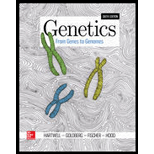
Concept explainers
F. Port and S. Bullock at the University of Cambridge (UK) designed the elegant plasmid vector pCFD3 for the expression of sgRNAs in Drosophila. The following figure shows a part of this vector. The orange sequences are part of a strong promoter (transcription from this promoter starts at the G in bold—which must be present—and goes from left to right). The purple sequences are a portion of the tracrRNA component of the sgRNA. After cutting the pCFD3 plasmid with the restriction enzyme BbsI (whose recognition site is also shown in the following figure), you will replace the blue sequences in the figure with sequences that will allow the expression of an sgRNA that targets a Drosophila gene called NiPp1.

The last part of the jigsaw puzzle you will need is the following sequence, which shows part of the NiPp1 gene including the triplet corresponding to the start codon. Capital letters are in the gene’s first exon with the coding region in blue; lowercase letters are in the first intron. The NiPp1 protein is 383 amino acids long. Your assignment is to generate a knockout allele of this gene by inducing Cas9 to produce a double-strand break into the gene that will be repaired imprecisely by nonhomologous end-joining (NHEJ).
![]()
| a. | Identify the two PAM sites in this sequence. Which of these PAM sites would you want to use in order to produce a null allele of the NiPp1 gene? Why would you prefer this site? |
| b. | If you targeted Cas9 to the proper location in the NiPp1 gene, and the resultant double-strand break was repaired imprecisely by NHEJ (so that a few—usually ≤6 bp are deleted or added at that location), about what percentage of the imprecisely repaired genes could you say with confidence would be null alleles? Explain. |
| c. | Diagram the pCFD3 vector after it has been cut with the BbsI enzyme. Don’t worry about the small blue fragment that will be removed; the emphasis here is to show the 5′-overhangs that will be made. |
| d. | Design two 24-nt DNA oligonucleotides that you could anneal together and clone into BbsI-cut pCFD3 vector so that the recombinant plasmid could express an sgRNA useful for making null mutations in the NiPp1 gene. |
| e. | Show exactly where Cas9 would cut the NiPp1 gene. |
| f. | Briefly outline what you would do with your recombinant plasmid to make a null mutation in the fly NiPp1 gene. |
| g. | Briefly outline how you would modify this technique to generate a knockin allele in which the first amino acid in the NiPp1 protein after the initiating Met (that is, Thr) would be changed to Ala. |
Want to see the full answer?
Check out a sample textbook solution
Chapter 18 Solutions
Genetics: From Genes to Genomes
- Molecular Biology Question Please help. Thank you Explain what is meant by the term “defective virus.” Explain how a defective virus is able to replicate.arrow_forwardMolecular Biology Explain why changing the codon GGG to GGA should not be harmful. Please help . Thank youarrow_forwardStage Percent Time in Hours Interphase .60 14.4 Prophase .20 4.8 Metaphase .10 2.4 Anaphase .06 1.44 Telophase .03 .72 Cytukinesis .01 .24 Can you summarize the results in the chart and explain which phases are faster and why the slower ones are slow?arrow_forward
- Can you circle a cell in the different stages of mitosis? 1.prophase 2.metaphase 3.anaphase 4.telophase 5.cytokinesisarrow_forwardWhich microbe does not live part of its lifecycle outside humans? A. Toxoplasma gondii B. Cytomegalovirus C. Francisella tularensis D. Plasmodium falciparum explain your answer thoroughly.arrow_forwardSelect all of the following that the ablation (knockout) or ectopoic expression (gain of function) of Hox can contribute to. Another set of wings in the fruit fly, duplication of fingernails, ectopic ears in mice, excess feathers in duck/quail chimeras, and homeosis of segment 2 to jaw in Hox2a mutantsarrow_forward
- Select all of the following that changes in the MC1R gene can lead to: Changes in spots/stripes in lizards, changes in coat coloration in mice, ectopic ear formation in Siberian hamsters, and red hair in humansarrow_forwardPleiotropic genes are genes that (blank) Cause a swapping of organs/structures, are the result of duplicated sets of chromosomes, never produce protein products, and have more than one purpose/functionarrow_forwardA loss of function mutation in Pitx1 enhancers can cause (blank) Removal of Pitx1 exons and growth of ectopic hindlimbs, growth of extra ectopic forelimbs, loss of forelimb specification and development, and loss of hindlimb specification and developmentarrow_forward
- Hox1a most likely contributes to (blank) patterning in the developing embryo? Ventral, posterior, limb or anteriorarrow_forwardSelect all of the following that can help establish Hox gene expression boundaries (things that affect Hox and not things that Hox affects). Retinoic acid, anterior/posterior axis, fibroblast growth factors, vagal neural crest, and enhancersarrow_forwardEctopic expression of Hox often results in (blank) phenotypes. (Blank) transformations are characterized by the replacement of one body part/structure with another. Hoxeotic, homealoneotic, joexotic, or homeoticarrow_forward
 Human Heredity: Principles and Issues (MindTap Co...BiologyISBN:9781305251052Author:Michael CummingsPublisher:Cengage Learning
Human Heredity: Principles and Issues (MindTap Co...BiologyISBN:9781305251052Author:Michael CummingsPublisher:Cengage Learning Biology Today and Tomorrow without Physiology (Mi...BiologyISBN:9781305117396Author:Cecie Starr, Christine Evers, Lisa StarrPublisher:Cengage Learning
Biology Today and Tomorrow without Physiology (Mi...BiologyISBN:9781305117396Author:Cecie Starr, Christine Evers, Lisa StarrPublisher:Cengage Learning Biology (MindTap Course List)BiologyISBN:9781337392938Author:Eldra Solomon, Charles Martin, Diana W. Martin, Linda R. BergPublisher:Cengage Learning
Biology (MindTap Course List)BiologyISBN:9781337392938Author:Eldra Solomon, Charles Martin, Diana W. Martin, Linda R. BergPublisher:Cengage Learning Biology 2eBiologyISBN:9781947172517Author:Matthew Douglas, Jung Choi, Mary Ann ClarkPublisher:OpenStaxCase Studies In Health Information ManagementBiologyISBN:9781337676908Author:SCHNERINGPublisher:Cengage
Biology 2eBiologyISBN:9781947172517Author:Matthew Douglas, Jung Choi, Mary Ann ClarkPublisher:OpenStaxCase Studies In Health Information ManagementBiologyISBN:9781337676908Author:SCHNERINGPublisher:Cengage Biology: The Dynamic Science (MindTap Course List)BiologyISBN:9781305389892Author:Peter J. Russell, Paul E. Hertz, Beverly McMillanPublisher:Cengage Learning
Biology: The Dynamic Science (MindTap Course List)BiologyISBN:9781305389892Author:Peter J. Russell, Paul E. Hertz, Beverly McMillanPublisher:Cengage Learning





